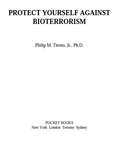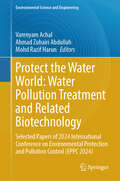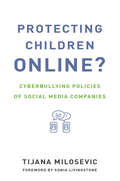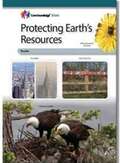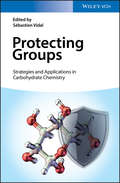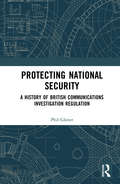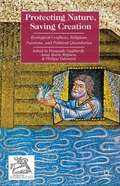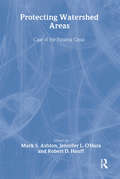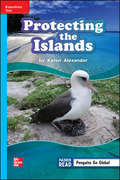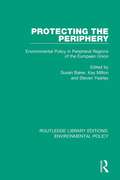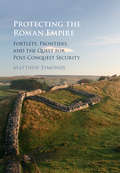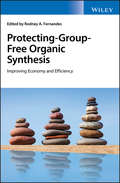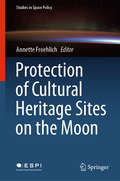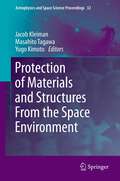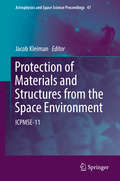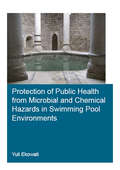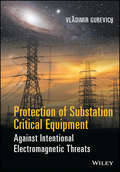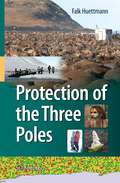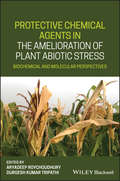- Table View
- List View
Protect Yourself Against Bioterrorism
by Philip M. Tierno Jr.How does anthrax spread? Should I avoid opening my mail? Wasn't I vaccinated for smallpox years ago? What exactly is encephalitis? Is my workplace a target for bioterrorism? What precautions can I take to stay healthy and safe? PROTECT YOURSELF AGAINST BIOTERRORISM. From fears of full-scale germ warfare to the spread of dangerous and deadly illnesses, we are faced with a new breed of anxiety -- and more questions than ever -- about our safety and well-being in the face of bioterrorism. Dr. Philip M. Tierno, a member of the New York City Mayor's Task Force on Bioterrorism, addresses our fears with the most powerful antidote: information. Dr. Tierno explains: how germs can be used as potential weapons and how they can't, how to distinguish the symptoms of a deadly disease from a run-of-the-mill bug, how these diseases are treated, how to assess the level of risk we face in our daily lives, how to sort fact from myth in the face of frightening new developments, what you can do to safeguard your family's health, and more.
Protect the Water World: Selected Papers of 2024 International Conference on Environmental Protection and Pollution Control (EPPC 2024) (Environmental Science and Engineering)
by Varenyam Achal Ahmad Zuhairi Abdullah Mohd Razif HarunThis book unveils the advancements in water pollution analysis and its biological treatment technology and provides valuable research and experience for engineers and scholars. On March 22, 2024, in the United Nations World Water Development Report, the theme of this year's conference, "Water for Promoting Prosperity and Peace," aligns with Global Water Partnerships' long-standing mission and vision of integrated water resources management. Currently, around half of the world's population faces severe water scarcity for at least part of the year, and a quarter of the global population experiences "extremely high" water stress. Meanwhile, global freshwater usage is growing at a rate slightly below 1% annually. Hence, the protection of water resources and pollution control, particularly the renewal and management of freshwater resources, deserve significant attention. Emerging pollutants of concern include per- and polyfluoroalkyl substances (PFAS), pharmaceuticals, hormones, industrial chemicals, detergents, cyanotoxins, and nanomaterials. High concentrations of antimicrobial agents have been found worldwide, originating from inadequately treated household wastewater, livestock, and aquaculture. Biological treatment technology for water pollution uses microorganisms to break down pollutants into harmless or less toxic substances, becoming an important means of addressing water pollution. Its advantages lie in low cost, adaptability, and the ability to effectively treat various organic pollutants, including hydrocarbons, pharmaceuticals, and pesticides. However, the effectiveness of this technology depends on the selection of appropriate microbial strains and the optimization of treatment conditions (such as temperature, pH, and nutrients). In the aspect of water pollution analysis, accurate detection of the types and concentrations of pollutants is a prerequisite for management and remediation. Modern instruments, such as gas chromatography-mass spectrometry (GC-MS) and liquid chromatography-mass spectrometry (LC-MS), can identify and quantify trace pollutants in complex water bodies. Additionally, new-generation sensing technologies and biological detection tools, like DNA microarrays and gene sequencing technologies, enable rapid detection of specific pollutants and reveal microbial community responses to pollutants. These technologies can effectively target and treat heavy industrial and chemical pollution, thereby protecting water environmental safety. This book aims to facilitate the exchange of scientific information among scholars from leading universities, research centers, and high-tech enterprises around the world. This book is highly beneficial to scholars, engineers, and researchers in the fields of environmental engineering and water pollution.
Protected Areas
by John G. Robinson Jonathan E. Bailie Lucas N. JoppaProtected areas spearhead our response to the rapidly accelerating biodiversity crisis. However, while the number of protected areas has been growing rapidly over the past 20 years, the extent to which the world's protected areas are effectively conserving species, ecosystems, and ecosystem services is poorly understood. Highlights new techniques for better management and monitoring of protected areas Sets guidelines for the decision making processes involved in setting up and maintaining protected areas Fully international in scope and covering all ecosystems and biomes
Protecting Children Online?: Cyberbullying Policies of Social Media Companies (The Information Society Series)
by Tijana MilosevicA critical examination of efforts by social media companies—including Facebook, Twitter, Snapchat, and Instagram—to rein in cyberbullying by young users.High-profile cyberbullying cases often trigger exaggerated public concern about children's use of social media. Large companies like Facebook respond by pointing to their existing anti-bullying mechanisms or coordinate with nongovernmental organizations to organize anti-cyberbullying efforts. Do these attempts at self-regulation work? In this book, Tijana Milosevic examines the effectiveness of efforts by social media companies—including Facebook, Twitter, YouTube, Snapchat, and Instagram—to rein in cyberbullying by young users. Milosevic analyzes the anti-bullying policies of fourteen major social media companies, as recorded in companies' corporate documents, draws on interviews with company representatives and e-safety experts, and details the roles of nongovernmental organizations examining their ability to provide critical independent advice. She draws attention to lack of transparency in how companies handle bullying cases, emphasizing the need for a continuous independent evaluation of effectiveness of companies' mechanisms, especially from children's perspective. Milosevic argues that cyberbullying should be viewed in the context of children's rights and as part of the larger social problem of the culture of humiliation.Milosevic looks into five digital bullying cases related to suicides, examining the pressures on the social media companies involved, the nature of the public discussion, and subsequent government regulation that did not necessarily address the problem in a way that benefits children. She emphasizes the need not only for protection but also for participation and empowerment—for finding a way to protect the vulnerable while ensuring the child's right to participate in digital spaces.
Protecting Earth's Resources
by Core Knowledge FoundationProtecting Earth’s Resources introduces Grade 5 students to real-world examples and fundamental concepts that will be explored in greater depth in later grades. Students will research efforts that many communities take to reduce the impacts of using natural resources. Using their knowledge of how water, air, and land are used for daily needs, students create a series of action/protection plans, which they will have the option to present to a selected audience of experts. Each part of this unit engages students to learn of specific natural resources used to meet human needs and how communities work to minimize any negative effects of use.
Protecting Groups: Strategies and Applications in Carbohydrate Chemistry
by Sebastien VidalA unique overview of the most important protecting group strategies in carbohydrate chemistry Protecting Groups: Strategies and Applications in Carbohydrate Chemistry provides a detailed account of key strategies and methodologies for the protection of carbohydrates. Divided into two parts, the first focuses on groups that are used best to protect a specific position on a carbohydrate. In the second part, specific carbohydrate residues or compounds are discussed in the context of a specific protecting group strategy used to reach the desired regioisomer. This important book: -Features chapters on protecting groups at the primary and secondary positions of carbohydrates -Describes protecting group strategies towards sialic acid derivatives, glycofuranoses, sulfated glycosaminoglycans, and cyclodextrins -Provides information on automated glycan assembly -Includes a chapter on the industrial scale synthesis of heparin analogs Written by a team of leaders in the field, Protecting Groups: Strategies and Applications in Carbohydrate Chemistry is an indispensable guide for academics and industrial researchers interested in carbohydrate and natural product synthesis, pharmaceutical chemistry, and biochemistry.
Protecting National Security: A History of British Communications Investigation Regulation
by Phil GloverThis book contends that modern concerns surrounding the UK State’s investigation of communications (and, more recently, data), whether at rest or in transit, are in fact nothing new. It evidences how, whether using common law, the Royal Prerogative, or statutes to provide a lawful basis for a state practice traceable to at least 1324, the underlying policy rationale has always been that first publicly articulated in Cromwell’s initial Postage Act 1657, namely the protection of British ‘national security’, broadly construed. It further illustrates how developments in communications technology led to Executive assumptions of relevant investigatory powers, administered in conditions of relative secrecy. In demonstrating the key role played throughout history by communications service providers, the book also charts how the evolution of the UK Intelligence Community, entry into the ‘UKUSA’ communications intelligence-sharing agreement 1946, and intelligence community advocacy all significantly influenced the era of arguably disingenuous statutory governance of communications investigation between 1984 and 2016. The book illustrates how the 2013 ‘Intelligence Shock’ triggered by publication of Edward Snowden’s unauthorized disclosures impelled a transition from Executive secrecy and statutory disingenuousness to a more consultative, candid Executive and a policy of ‘transparent secrecy’, now reflected in the Investigatory Powers Act 2016. What the book ultimately demonstrates is that this latest comprehensive statute, whilst welcome for its candour, represents only the latest manifestation of the British state’s policy of ensuring protection of national security by granting powers enabling investigative access to communications and data, in transit or at rest, irrespective of location.
Protecting Nature, Saving Creation
by Pasquale Gagliardi Anne Marie Reijnen Philipp ValentiniCan religions help us tackle the ecological crisis we are now facing? Can we redefine our relationship with the Earth, giving spiritual depth to ecological issues? This book attempts to answer these questions by exploring the relationship between ecology and theology.
Protecting Public Health and the Environment: Implementing The Precautionary Principle
by Wes Jackson Joel Tickner Carolyn RaffenspergerProtecting Public Health and the Environment describes the history, specific content, and scientific and philosophical foundations of the principle of precautionary action.
Protecting THOSE WHO SERVE: Strategies to Protect the Health of Deployed U.S. Forces
by Committee on Strategies to Protect the Health of Deployed U.S. ForcesSince the Gulf War ended in 1991, various constituencies, including a significant number of veterans, speculate that unidentified risk factors led to chronic, medically unexplained illnesses, and these constituencies challenge the depth of the military’s commitment to protect the health of deployed troops. Despite general concurrence in findings to support these claims, few changes have been made at the field level. The most important recommendations remain unimplemented, despite the compelling rationale for urgent action. Protecting Those Who Serve illuminates these recommendations and government-developed plans that remain inactive due to a lack of authority within the Department of Defense, while describing the dangers that may result from failure to protect our forces in the field.
Protecting Watershed Areas: Case of the Panama Canal
by P Mark S Ashton Jennifer L O'Hara Robert D HauffProtecting Watershed Areas: Case of the Panama Canal provides foresters, hydrologists, and park managers with a case study of the Panama Canal watershed area to help you make the most of your efforts in protecting ecological areas. Through this unique book, you will discover how the Carter-Torrijos treaty that will return the Panama Canal to the Republic of Panama on December 31, 1999 will affect the 2.6 million inhabitants of that area as well as this complex ecosystem. This valuable book includes a focus on both technical and biological observations in the field as well as library research to help you make the most of book learning and field research in your endeavors to protect forest reserves and other protected areas. Protecting Watershed Areas offers you insight into the Panama Canal area through informal interviews, key informants, field data, and research that focuses on both the technical and biological aspects of environmental management, such as agroforestry and reforestation, of environmental management and on policy and institutional dimensions of management to provide you with a unique perspective of the dynamics of this area. The Panama canal watershed area is one of the world?s most complex managed ecosystems and through this insightful volume, you will find new ways to deal with the myriad of problems you may encounter in ecosystem management, such as:realizing that single resource management is no longer adequate and taking a more holistic approach to management, such as taking into consideration whole ecosystems or watersheds will enable you to fully protect the area you are trying to servediscovering how the trend of privitization and nongovernmental ownership of protected areas impacts the job of managing our precious national resourcesunderstanding that for effective and stable protected area management to occur, you must have a clear understanding of the historical and social context that has shaped the particular circumstances of each siterecognizing larger national and international factors in order to control the often devastating effects of tourism on protected areascreating clear directives and priorities before developing conservation programs to make program implementation easierInformative and insightful, Protecting Watershed Areas examines the most current ideas in protected areas management through a unique case study of the Panama Canal. This essential book provides you with several answers to the challenges facing Panama that you can apply to forest reserve and other protected areas programs around the globe due to the paramount importance of developing sustainable land-use systems. With Protecting Watershed Areas, you will discover how to effectively balance securing goods and services from a region, such as farming and tourism without threatening the overall integrity of the ecological systems and meeting human needs and values.
Protecting the Islands (Reading Wonders #Approaching Level, Grade 3)
by Karen AlexanderNIMAC-sourced textbook
Protecting the Mind: Challenges in Law, Neuroprotection, and Neurorights (Ethics of Science and Technology Assessment #49)
by Luca Valera Pablo López-SilvaThis book offers a comprehensive analysis of philosophical, social, ethical, and legal challenges arising as a consequences of current advances in neurosciences and neurotechnology. It starts by offering an overview of fundamental concepts such as mental privacy, personal autonomy, mental integrity, and responsibility, among others. In turn, it discusses the influence of possible misuses or uncontrolled uses of neurotechnology on those concepts, and, more in general, on human rights and equality. Then, it makes some original proposals to deal with the main ethical, legal, and social problems associated to the use of neurotechnology, both in medicine and in everyday life, suggesting possible policies to protect privacy, neural data, and intimacy. Crossing the borders between humanities, natural sciences, bio-medicine, and engineering, and taking into account geographical and cultural differences, this book offers a conceptual debate around policy and decision making concerning some of the key neuroethical challenges of our times. It offers a comprehensive guide to the most important issues of neurojustice and neuroprotection, together with a set of new paradigms to face some of the most urgent neuroethical problems of our times.
Protecting the Periphery: Environmental Policy in Peripheral Regions of the European Union (Routledge Library Editions: Environmental Policy #1)
by Steven Yearley Susan Baker Kay MiltonFirst published in 1994. ln Protecting the Periphery the editors present a series of papers revealing the impact of EU policies on environmental quality in regions at the edge of the European Union and in those lying just outside it. In many cases these regions contain habitats and landscapes of international importance; they have also often escaped some of the environmental damage caused by industrialization. But, as the papers' reveal, attempts by the EU to safeguard these environmental benefits are often contradicted by the EU’s own development policies, bringing air pollution from new roads, contamination from new industries, and leading to habitat destruction from modern agricultural practices and increases in tourism. As the Union pushes for the deepening of the integration process, including completing the internal market, the pressures on the periphery's environment are increasing. Furthermore, the efforts of the periphery to catch-up economically with the developed core can often heighten the tension between economic considerations on the one hand and the need for environmental protection on the other. The studies in this book examine the ambivalent responses to EU environmental policy among policy-makers and environmentalists in the periphery. Both the willingness as well as the capacity of the periphery to protect its environmental heritage are explored. In particular, the administrative capacity, institutional arrangements, political culture as well as economic development needs are taken into account in an examination of the nature of the periphery’s response to and implementation of Union environmental policy. The book will appeal to policy-makers and academics in the countries of the European periphery and to analysts of European policy-making everywhere, especially those concerned with environmental policy and politics.
Protecting the Roman Empire: Fortlets, Frontiers, and the Quest for Post-Conquest Security
by Matthew SymondsThe Roman army enjoys an enviable reputation as an instrument of waging war, but as the modern world reminds us, an enduring victory requires far more than simply winning battles. When it came to suppressing counterinsurgencies, or deterring the depredations of bandits, the army frequently deployed small groups of infantry and cavalry based in fortlets. This remarkable installation type has never previously been studied in detail, and shows a new side to the Roman army. Rather than displaying the aggressive uniformity for which the Roman military is famous, individual fortlets were usually bespoke installations tailored to local needs. Examining fortlet use in north-west Europe helps explain the differing designs of the Empire's most famous artificial frontier systems: Hadrian's Wall, the Antonine Wall, and the Upper German and Raetian limites. The archaeological evidence is fully integrated with documentary sources, which disclose the gritty reality of life in a Roman fortlet.
Protecting-Group-Free Organic Synthesis: Improving Economy and Efficiency
by Rodney A. FernandesPresents a comprehensive account of established protecting-group-free synthetic routes to molecules of medium to high complexity This book supports synthetic chemists in the design of strategies, which avoid or minimize the use of protecting groups so as to come closer to achieving an “ideal synthesis” and back the global need of practicing green chemistry. The only resource of its kind to focus entirely on protecting-group-free synthesis, it is edited by a leading practitioner in the field, and features enlightening contributions by top experts and researchers from across the globe. The introductory chapter includes a concise review of historical developments, and discusses the concepts, need for, and future prospects of protecting-group-free synthesis. Following this, the book presents information on protecting-group-free synthesis of complex natural products and analogues, heterocycles, drugs, and related pharmaceuticals. Later chapters discuss practicing protecting-group-free synthesis using carbohydrates and of glycosyl derivatives, glycol-polymers and glyco-conjugates. The book concludes with a chapter on latent functionality as a tactic toward formal protecting-group-free synthesis. A comprehensive account of established protecting-group-free (PGF) synthetic routes to molecules of medium to high complexity Benefits total synthesis, methodology development and drug synthesis researchers Supports synthetic chemists in the design of strategies, which avoid or minimize the use of protecting groups so as to come closer to achieving an “ideal synthesis” and support the global need of practicing green chemistry Covers a topic that is gaining importance because it renders syntheses more economical Protecting-Group-Free Organic Synthesis: Improving Economy and Efficiency is an important book for academic researchers in synthetic organic chemistry, green chemistry, medicinal and pharmaceutical chemistry, biochemistry, and drug discovery.
Protection of Cultural Heritage Sites on the Moon (Studies in Space Policy #24)
by Annette FroehlichThis book provides an extensive overview of the protection of cultural heritages sites on the Moon (humanity’s lunar heritage) and the various threats they face. First of all, the international legal framework, especially the relevant space treaties are analyzed in terms of how they protect cultural heritages sites on the Moon. In turn, the book explores key aspects like the application of customary law, the UNESCO World Heritage Convention, or the Underwater Convention, and the possibility of adding these sites to UNESCO’s World Heritage list. The book subsequently addresses the question of how to define culture heritage sites or artifacts, in particular in view of the “Outstanding Universal Value” criterion, which is a vital aspect in order to differentiate them from space garbage or even space threats. Lastly, the book proposes and elaborates on various protection systems and multilateral protection regulations. Especially now, 50 years after the first human landing on the Moon, the book is a timely publication that will be of interest to all scholars and professionals working in the space field.
Protection of Global Biodiversity: Converging Strategies
by Jeffrey Mcneely Lakshman D. GuruswamyThe rate of extinction of biological species is greater today than at any time in the last 65 million years. Some predict that if this rate continues, two-thirds of all living species will disappear during the next century. Because reaching consensus on specific courses of action involves complex issues, any adequate response to this impending crisis must include coverage of many areas of inquiry and understanding. Protection of Global Biodiversity features essays by distinguished international experts who communicate with each other across disciplinary boundaries to address the challenge of formulating policies to protect biodiversity.Although the global community has recently adopted a Convention of Biological Diversity, the agreement sets forth only abstract goals. Contributors to this volume advance the Convention's initial steps by providing workable solutions that can be implemented regionally, nationally, and locally. The contributors--including natural, social, and political scientists; economists; lawyers; and environmentalists; and decisionmakers in business, agriculture, and government--have united to create a common discourse and to evaluate and propose strategies for halting this alarming loss of biodiversity. In recognizing the diverse aspects of this task--scientific, economic, institutional, moral, and legal--this book presents a new picture of emerging action.Contributors. S. James Anaya, Gregory Benford, Graciela Chichilnisky, S. Todd Crider, Yvonne Cripps, Robert T. Fraley, Anil K. Gupta, Lakshman D. Guruswamy, G. M. Heal, Brent Hendricks, Robert B. Horsch, Laura L. Jackson, Annie Lovejoy, Ariel E. Lugo, Jeffrey A. McNeely, Brian G. Norton, Elinor Ostrom, Peter H. Raven, John W. Reid, Walter V. Reid, Mark Sagoff, Roger A. Sedgo, R. David Simpson, Ana Sittenfeld, Christopher D. Stone, Gary H. Toenniessen
Protection of Materials and Structures From the Space Environment
by Jacob Kleiman Masahito Tagawa Yugo KimotoThe goals of the 10th International Space Conference on "Protection of Materials and Structures from Space Environment" ICPMSE-10J, since its inception in 1992, have been to facilitate exchanges between members of the various engineering and science disciplines involved in the development of space materials, including aspects of LEO, GEO and Deep Space environments, ground-based qualification, and in-flight experiments and lessons learned from operational vehicles that are closely interrelated to disciplines of the atmospheric sciences, solar-terrestrial interactions and space life sciences. The knowledge of environmental conditions on and around the Moon, Mars, Venus and the low Earth orbit as well as other possible candidates for landing such as asteroids have become an important issue, and protecting both hardware and human life from the effects of space environments has taken on a new meaning in light of the increased interest in space travel and colonization of other planets. And while many material experiments have been carried out on the ground and in open space in the last 50 years (LDEF, MEEP, SARE, MISSE, AOP, DSPSE, ESEM, EURECA, HST, MDIM, MIS, MPID, MPAC and SEED), many questions regarding the environmental impact of space on materials remain either poorly understood or unanswered. The coming generations of scientists will have to continue this work and tackle new challenges, continuing to build the level of confidence humans will need to continue the colonization of space. It is hoped that the proceedings of the ICPMSE-10J presented in this book will constitute a small contribution to doing so.
Protection of Materials and Structures from the Space Environment
by Jacob KleimanThe proceedings published in this book document and foster the goals of the 11th International Space Conference on "Protection of Materials and Structures from Space Environment" ICPMSE-11 to facilitate exchanges between members of the various engineering and science disciplines involved in the development of space materials. Contributions cover aspects of interaction with space environment of LEO, GEO, Deep Space, Planetary environments, ground-based qualification and in-flight experiments, as well as lessons learned from operational vehicles that are closely interrelated to disciplines of atmospheric sciences, solar-terrestrial interactions and space life sciences.
Protection of Modern Power Systems
by Janaka B. Ekanayake Vladimir Terzija Ajith Tennakoon Athula RajapakseProtection of Modern Power Systems Familiarize yourself with the cutting edge of power system protection technology All electrical systems are vulnerable to faults, whether produced by damaged equipment or the cumulative breakdown of insulation. Protection from these faults is therefore an essential part of electrical engineering, and the various forms of protection that have developed constitute a central component of any course of study related to power systems. Particularly in recent decades, however, the demands of decarbonization and reduced dependency on fossil fuels have driven innovation in the field of power systems. With new systems and paradigms come new kinds of faults and new protection needs, which promise to place power systems protection once again at the forefront of research and development. Protection of Modern Power Systems offers the first classroom-ready textbook to fully incorporate developments in renewable energy and ‘smart’ power systems into its overview of the field. It begins with a comprehensive guide to the principles of power system protection, before surveying the systems and equipment used in modern protection schemes, and finally discussing new and emerging protection paradigms. It promises to become the standard text in power system protection classrooms. Protection of Modern Power Systems readers will also find: Treatment of the new faults and protection paradigms produced by the introduction of new renewable generators Discussion of SmartGrids—intelligently-controlled active systems designed to integrate renewable energy into the power system—and their protection needs Detailed exploration of Synchronized Measurement Technology and Intelligent Electronic Devices Accompanying website to include Solutions Manual for instructors Protection of Modern Power Systems is an essential resource for students, researchers, and system engineers looking for a working knowledge of this critical subject.
Protection of Public Health from Microbial and Chemical Hazards in Swimming Pool Environments (IHE Delft PhD Thesis Series)
by Yuli EkowatiThis thesis describes the occurrence of microbial and chemical contaminants in swimming pools and the investigation of an alternative disinfection technology, UVOX Redox® that could reduce reliance on chlorine and the formation of chlorinated disinfection byproducts (DBPs) in swimming pools. This technology was effective in inactivation of chlorine resistant microorganisms, represented by Bacillus subtilis spores, and in combination with chlorine generated lower concentrations of chlorinated DBPs compared to chlorination alone. It enhanced the removal of pharmaceuticals and personal care products (PPCPs), which were frequently present in indoor, outdoor and spa pools. Carbamazepine and 1H-benzotriazole were the most frequently detected PPCPs, while hydrochlorothiazide and 4-methylbenzylidene camphor were detected at the highest concentration. An investigation of seven different swimming pool facilities showed that clinically relevant fungi were omnipresent. Floors at the sites where the pool visitors converge, such as the exit leading to shower rooms, showed the highest fungal concentrations. The distribution of fungi inside the swimming pool facilities highlighted potential transmission pathways and a possible risk of fungal infections. Future swimming pool water guidance should include raising awareness among swimmers, pool operators and managers about hygienic behaviour and better hygiene measures, and application of alternative disinfection technologies such as UVOX. Key features: Identifies clinically relevant fungi in swimming pool environments Identifies potential transmission pathways of clinically relevant fungi in indoor swimming pools Highlights the occurrence of PPCPs in different type of pools and their relation with pool water treatment Assesses an alternative disinfection technology for swimming pool water treatment.
Protection of Substation Critical Equipment Against Intentional Electromagnetic Threats
by Vladimir GurevichThe modern microprocessor based electronic equipment most vulnerable to Intentional Destructive Electromagnetic Interferences (IDEI) includes High-Altitude Electromagnetic Pulse (HEMP) in all substation equipment. However, power equipment and especially transformers are also subject to the influence of HEMP. The book discusses problems and solutions for both kinds of substation equipment. Separated into eight chapters, the book covers: Technological progress and its consequences; Intentional Destructive Electromagnetic Interferences (IDEI); Methods and means of Digital Protective Relay (DPR) protection from electromagnetic pulse; Passive methods and means of DPR protection from electromagnetic pulse; Active methods and means of DPR protection from electromagnetic pulse; Tests of DPR resistance to IDEI impacts; Organizational and technical measures to protect DPR from HEMP; and Protection of power equipment and transformers from HEMP. Key features: • Practical approach focusing on technical solutions for difficult problems. • Full data on electromagnetic threats and methods of their prevention are concentrated. • Addresses a gap in knowledge in the power system industry. This book emphasizes practical recommendations on protection of power substations' electric equipment from IDEI that intended for not only staff operating electric equipment, but also for manufacturers of this equipment, specialists of designing companies, managers of electric energy industry as well as for teachers and postgraduate students.
Protection of the Three Poles
by Falk HuettmannThe Arctic, the Antarctic, and the Hindu Kush-Himalayas form a trio of terrains sometimes called "the three poles". Mainly composed of rock, snow, and ice, these precious regions, which are home to many unique species such as the polar bear, the emperor penguin, and the snow leopard, contain the primary water resource of this planet and directly shape our climate. This book presents a first-ever global assessment and progressive review of the three poles and demonstrates the urgent need for their protection. Sins of the past have irrevocably harmed and threatened many of the unique qualities of these regions, and the future looks bleak with the global population forecast to reach 9 billion by 2060, and with climate change on the rise. Presented here is a wide-reaching and coherent overview of the three poles' biodiversity, habitats, and ongoing destruction. Failed protection and social targets set by the United Nations and other bodies are exposed while economic growth, unconstrained or inappropriate development, and urban sprawl are promoted unabated. Polar regions play a major role in the global agenda as they are rich in oil and other resources, marking them for contamination, overfishing, and further degradation. Tourism in the Antarctic has benefited from enlightened self-regulation, but there are signs that this is changing, too. The chapters of this book are written by experts in their fields, and their evidence leaves no doubt that we already live beyond our carrying capacity on a finite but decaying space. A global protection role model and several outlook scenarios are proposed to help set in motion polar protection priorities that are actually valid. Humanity has demonstrated through international treaties such as the Antarctic Treaty and the Madrid Protocol that we can put the interests of the planet as a whole first. This must become the norm, not the exception.
Protective Chemical Agents in the Amelioration of Plant Abiotic Stress: Biochemical and Molecular Perspectives
by Durgesh Kumar Tripathi Aryadeep RoychoudhuryA guide to the chemical agents that protect plants from various environmental stressors Protective Chemical Agents in the Amelioration of Plant Abiotic Stress offers a guide to the diverse chemical agents that have the potential to mitigate different forms of abiotic stresses in plants. Edited by two experts on the topic, the book explores the role of novel chemicals and shows how using such unique chemical agents can tackle the oxidative damages caused by environmental stresses. Exogenous application of different chemical agents or chemical priming of seeds presents opportunities for crop stress management. The use of chemical compounds as protective agents has been found to improve plant tolerance significantly in various crop and non-crop species against a range of different individually applied abiotic stresses by regulating the endogenous levels of the protective agents within plants. This important book: Explores the efficacy of various chemical agents to eliminate abiotic stress Offers a groundbreaking look at the topic and reviews the most recent advances in the field Includes information from noted authorities on the subject Promises to benefit agriculture under stress conditions at the ground level Written for researchers, academicians, and scientists, Protective Chemical Agents in the Amelioration of Plant Abiotic Stress details the wide range of protective chemical agents, their applications, and their intricate biochemical and molecular mechanism of action within the plant systems during adverse situations.
